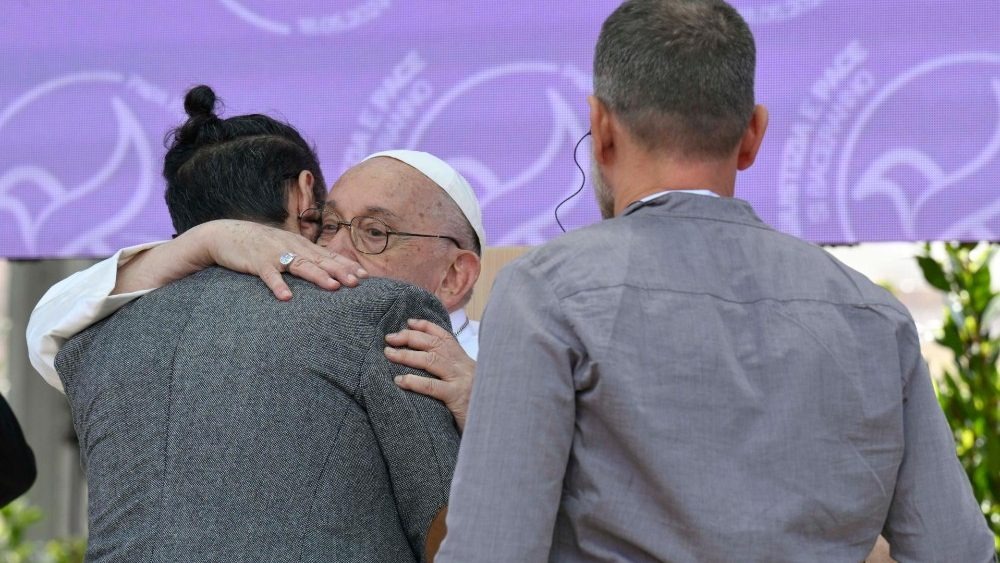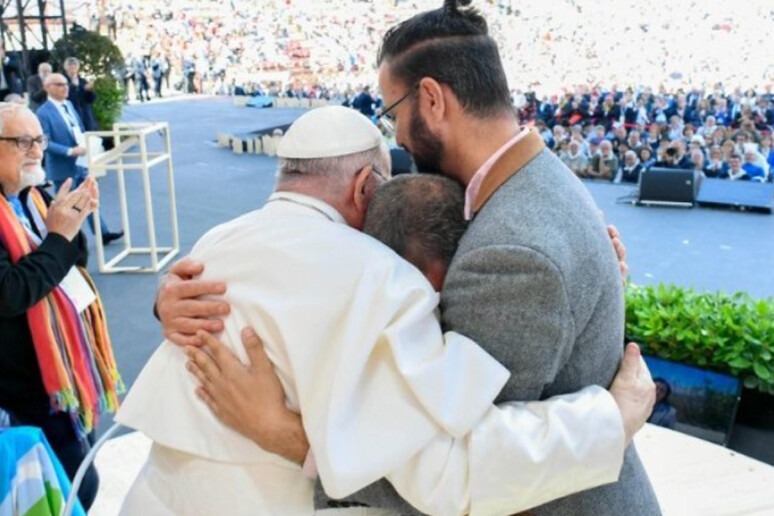(ZENIT News / Rome, 05.20.2024).- Verona is the city where Shakespeare set one of his best known works: “Romeo and Juliet.” And to this city in the north of Italy Pope Francis went by helicopter to take part in a meeting for peace, together with an assorted conglomerate of pacifist Associations and Movements. It was in that context that one of the events that summarized the visit happened: the embrace of an Israeli and a Palestinian in front of the Holy Father.
With that “Shakespearian” embrace, the Pope’s intense week ended, which opened with one of the most important meetings for the unity of the Catholic Church, held on Monday, May 12, with a delegation of the Syro-Malabar Catholic Church in Rome. The delegation of the second largest Eastern-Catholic community in communion with the Pope came to the meeting, headed by its Major Archbishop but also with an old problem: the division over the liturgy. In fact, the Pope addressed this issue and said to them:
To preserve unity, therefore, is not a pious exhortation but a duty, and it is so especially when it is a question of priests who have promised obedience and of whom the believing people expect an example of charity and meekness.

However, while the Pope called some to unity, 1,758 kilometers from the Clementine Hall of the Vatican’s Apostolic Palace, a schism was taking place: some Poor Clare nuns of Belorado in Spain were declaring themselves “sedevacantists,” namely, that they do not recognize any Pope after Pius XII. The fact that it was national news, obliged the Spanish Bishops to pronounce themselves.
And if on one hand division lurks, on the other the yearning for unity is encouraging: during a visit to Portugal, the Ecumenical Patriarch of Constantinople (symbolic leader of the Orthodox world) announced that Pope Francis will visit Turkey to commemorate the anniversary of the Council of Nicaea. Apparently the Pope has all the enthusiasm to travel, as the Archbishop of Luxembourg also announced that the Holy Father will visit the small dutchy. There will be another trip in June, but of fewer kilometers: the Pope will visit Rome’s Capitolio, headquarters of the city’s Mayor. The Capitolio is evocative as it recalls that it was in fact a Pope (Paul III) who had it made. The architect in charge was no less than Michelangelo.
This past week three other events made news: on one hand, after the exact dates of the opening and closing of the Jubilee 2025 were made known, the Apostolic Penitentiary announced how Indulgencnes can be gained during that period. There will be up to 14 ways to gain Indulgences, although that’s not the novelty; the novelty is that for the first time up to a maximum of two Indulgences can be gained daily.
Also awaited was the document initially announced as criteria to discern Marian apparitions. In the end, it was about something broader, although it also encompassed Marian apparitions. In a tight synthesis, the processes are simplified through prudential recognitions of six types and to be avoided henceforth is the use of the phrase “proof of supernaturality.” Needless to say, there were questions about Medjugorje in the Holy See Press Office, but there were more questions of Italian colleagues who had questions about the alleged apparitions of the Virgin of Trevignano, an apparition already disqualified by the local Bishop.
In the context of the Israeli invasion of Gaza, the Embassy of Israel to the Holy See raised its voice regarding a speech pronounced by Nobel Prize laureate Tawakkol Karman during an event on hunan fraternity, organized by the Fratelli Tutti Foundation. Karman described what is happening in Gaza as genocide. Israel’s Embassy tool exception to the term and published a note of protest.
Finally, precisely in Gaza, after three months of isolation as a result of the conflict in the Holy Land, Cardinal Pierbatista Pizzaballa was able to visit the Catholic community of Gaza. He also visited the Church of the Orthodox in Gaza to bring them some consolation. ZENIT has replicated the photos of that timely and necessary pastoral visit.
Thank you for reading our content. If you would like to receive ZENIT’s daily e-mail news, you can subscribe for free through this link.



